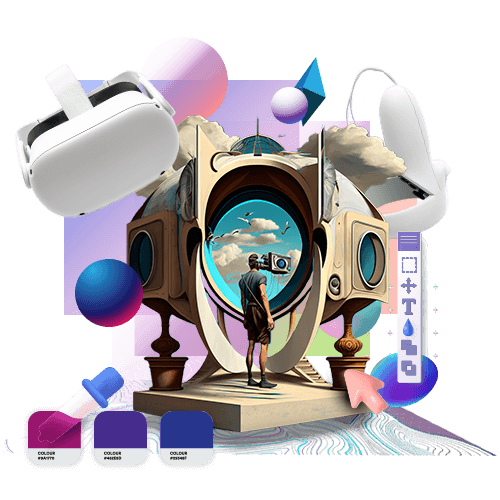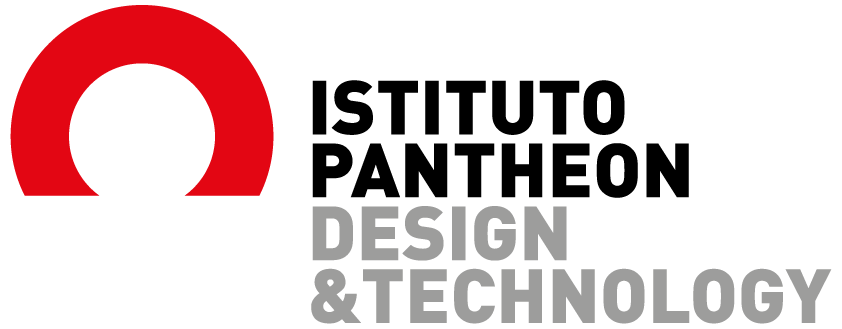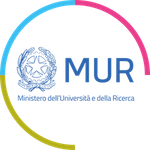Digital Applications The Visual Arts
PHOTOGRAPHY - VIDEO - VIRTUAL AND AUGMENTED REALITY
Visual language is expressed through beautiful things. Discover the artist in you and test yourself with different kinds of languages.

DESCRIPTION
ACADEMIC DIPLOMA PROFILE

SKILLS
- Office Suite
- Adobe Illustrator
- Adobe InDesign
- Adobe Photoshop
- Adobe Audition
- Adobe premiere
- Adobe After Effects
- Davinci Resolve
- Rhinoceros
- Asana
- Concept Board
- Blender
- Bubble/Bubble!
- Figma
- Unreal
- Unity
PROFESSIONAL FIGURES
Students of the First Level Academic Diploma in Digital Applications for Visual Arts, will be able to workfor traditional and digital communication and publishing, as well as for the web and advertising; they will be able to collaborate with other creative sectors such as photography, video editing, cinema (2D and 3D), video animations and videogames, acronyms and animated graphics for TV and web, virtual and augmented reality projects, such as:
- Graphic Designer
- Animation Designer
- Motion Graphic Designer
- User interface Designer
- User Experience Designer
- Junior Art Director
- Junior Film Maker
- Senior Video editor
- Illustrator
- Junior Unity Developer
- Virtual set designer
- Junior Real-time rendering developer
- Junior AR/VR consultant
PROGRAM
PROGRAM
1° YEAR
Morphology and Dynamics of Form
The widespread use of iconic languages and the development of new technologies, now irreversible, are cultural events of such great importance that they involve the whole of society, transforming the mental image that man has of the world and of himself. The effects of these events on the formative level are all to be explored: think, for example, of the mental conditioning that derives from television or advertising images, the loss of historical meaning, the different relationship between rational and irrational and so on.
History of contemporary art
Through thematic lessons and a conspicuous relative iconographic system, the course will provide basic knowledge of works and artists of the twentieth and twenty-first centuries. Introduced by a concise analysis of the historical avant-gardes of the turn of the century, this part of the course will focus on the stylistic and theoretical evolution that has characterized Western artistic research from the break made by Pollock’s dripping to the most recent contemporary proposals.
Considering the profound transformations that have taken place on the concept of “work of art” and on the speed of change of artistic language, we will try to dispel doubts and discomforts, clichés and false beliefs of a cultural adventure that has crossed and upset the parameters of the last sixty years and which continues to be, against all odds, vital and engaging.
Drawing For Decoration
Through the educational path, the student will be able to experiment with different decoration techniques, acquiring the ability to use these tools to communicate the project.
Audiovisual Theory
The course illustrates the main stages in the history of audiovisuals, from the birth of photography to the present day, through the relationship between technology and aesthetics. The stylistic, expressive and narrative evolutions of cinema are related to the technological advances of the means of production and the evolution of the cinematographic language.
Illustration
The aim of the course is to understand the professional traits of the Illustrator. It introduces the tools and methods of visual or narrative interpretation of specific themes or subjects. The goal is to help the students develop the ability to “look at things” with the eyes of those who, sooner or later, will find themselves having to design them adapting to the needs of a “profession” very different from free artistic expression.
Typology Of Materials
Through the course, students will be able to learn about materials that are used for graphics and are an integral part of the design work of communication products. You will be able to understand how to best set up your work during presentation to customers and how to use certain technologies to make communication products more attractive.
Computer Graphic
Aimed to develop the knowledge of the compositional space. The course will examine the applications of graphic design to focus on the relationship between typography and image aimed at building correct communication. In particular, students will acquire the tools and methods related to the structural setting of a correct hierarchy of elements. These skills are necessary to be able to fully manage a professional graphic project.
Digital Video
The course is a workshop where you can experiment with digital technology in the video field. Practice and theory have a parallel trend in order to activate multiple views on the various genres in which video technology is applied. Individual exercises of shooting, writing, editing and the analysis of audiovisual material belonging to different genres are particularly important. These exercises have as their purpose the research and experimentation of language and of the medium, preliminary to any classification.
English
The goal of this course is to help students to increase their language skills up to an intermediate level – B1 according to the Common European Framework of Reference for Languages (CEFR) – through a gradual path.
Fundamentals of Computer Science
The aim is to respond adequately to the challenge launched by the job market, not only through knowledge and deepening of cultural and technical areas, but also through the “tools” to use to carry out the process.
To master an adequate tool is an indispensable condition for achieving a valid and productive goal for our work needs.
PROGRAM
2° YEAR
Aesthetics
The course aims to introduce the ways in which the concept of “Aesthetics” is articulated in disciplines such as the history of art, favoring its theoretical aspects focused on the problem of knowledge of internal and external realities, through the relationship between analytic and imaginary reason, in a condition of continuous exchange, with entropy and difference.
Psychology of Art
The course deals with the relationships between content, image and narrative process adopted by the different forms of visual communication. The course aims to analyze the communication process and its mechanisms, using the methodologies developed by psychology in its various currents.
Digital photography
The course highlights the importance of photographic language as means of communication, expression and research both on a theoretical and a practical level. It provides the necessary teachings in order to develop and understand the importance of composition, to know the techniques of indoor and outdoor shooting, the treatment of sensitive material both in analogue and digital, the technology of the camera, the choice of equipment, the ‘exposure and measurement of light, the language of optics, landscape photography and professional studio photography, developing a specific knowledge of photographic language.
Graphics Techniques
The course deals with the media, the tools, and the techniques for the serial reproduction of a printed product. Starting from the paper and its characteristics, the course will cover also the various types of binding, the treatment of images, texts and graphic elements, the correct preparation of the files for the pre-printing procedures aimed at optimal reproduction in the different processes of printing: digital, typographic, offset, rotogravure, screen printing.
Contemporary Techniques
The aim of the course is to understand how contemporary forms of creativity (art, fashion, advertising, design) are born, represented and perceived.
Videographic
The course aims to provide theoretical and practical skills on non-linear editing systems and video post-production, as well as knowledge of the main video editing, post production and color correction software. Knowledge, morphology, classifications and the different meaning of the language of animated graphics will be taught with both theoretical and practical activities. The course will also focus on the use of video graphics software, techniques and new artistic experiences.
Digital Applications For Art
The course will deal with projects aimed at print, video and web, from cinema to multimedia, professional photo editing, graphic design and a correct and balanced work setting.
3D Modeling
The course will give students knowledge and in-depth study of commands and techniques for the visualization and spatial verification of each design idea and the production of basic three-dimensional drawings directly from the model. The possibility of applying the modeling technique ranges from mechanics, to design, to architectural drawing.
PROGRAM
3° YEAR
Audiovisual Techniques for the Web
The aim of the course is to give students the possibility of seeing, imagining and designing an audiovisual product for the web. Putting aside the limits imposed by normal commercial programs, students will analyze the trends of web communication and will find new and creative systems for a market that is constantly evolving.
Sound Design
The course aims to train students in the creation of a sound environment starting from a very important principle: designing sound is, first of all, a creative act that requires a basic knowledge of the fundamental constructive principles of sound and of music. The student will acquire the basic technical and theoretical skills to design sound with awareness and attention to the final aesthetic result, necessary in both the artistic and commercial fields.
Digital Image Processing
In-depth study of digital image processing techniques, software and tools used. Programs used: Adobe Photoshop, Adobe Illustrator, Adobe Indesign.
Latest Trends In Visual Arts
Through modernity, the historical avant-gardes, the transformations of the work of art between the fifties and seventies, up to the postmodern era and the current globalized world, the history of artistic trends and practices is continually placed in relationship with geography, culture, history.
Multimedia Languages
The course aims to analyze multimedia languages, shooting techniques and their application aimed at creating a multimedia product.
Computer Art
Studying the applications of the arts with the computer allows us to educate our vision on the contemporary, proposing research activities on the original principles of digital forms through the analysis of concepts, techniques and technologies adopted by artists in the last 25 years, in the fields of traditional fine arts, photography, cinema, animation, simulation, video games, design and illustration.
Internship
Students will be able to carry out an internship at a company or a professional studio in order to follow the development of a project from its conception to its realization, collaborating with professionals in the sector and practicing what they have studied.
Thesis
Each student will have to carry out a personal research work, through a written paper or a project, that will be discussed at the time of graduation.
First Level Academic Diploma authorized by MUR (Ministry of Education, University and Research)
with Ministerial Decree prot. No. 626 of 18 July 2013.
FILL OUT THE FORM
to receive more information.
We will contact you within a few hours.


